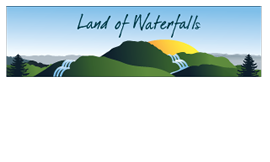For the next
several months Picturing the Past
will be presenting an A to Z tour of Transylvania County. We are starting off with A is for airstrip,
as in the former Camp Summit airstrip located within the current boundaries of
DuPont State Forest. The following
article was written by Kent Wilcox for the Friends of DuPont Forest
newsletter. For more information about
FODF visit their website at www.dupontforest.com
In the fall
of 1967, Ben Cart purchased more than 1,400 acres in Cedar Mountain from private
landowners and the DuPont Corporation. The mostly-forested land, locally
referred to as Buck Forest, encompassed portions of the watersheds of the
Little River and Reasonover Creek and was adjacent to a large tract of more
than 6,000 acres owned by the DuPont Corporation. Soon thereafter, Mr. Cart
built a dam on Reasonover Creek to create Lake Julia, which became the
centerpiece for his two summer camps, one for boys and one for girls, called
Summit Camps. By the mid 1970’s, youth from 25 states and several foreign
countries were enjoying their summer vacations at Summit Camps.
 |
| Ben Cart, Sr. beside his Beechcraft Bonanza airplane.
Photo courtesy Ben Cart, Sr. |
During the
off season, Mr. Cart traveled extensively around the country to promote Summit
Camps. He gave presentations about Summit Camps and met with parents and their
children at expositions sponsored by youth camping associations. Three of Mr.
Cart’s children had private pilot’s licenses and encouraged their father to do
the same. Mr. Cart attended ground school at Blue Ridge Community College,
obtained his pilot’s license, and purchased a Beechcraft Bonanza airplane to
use for business and pleasure. To make
his frequent traveling more convenient, he built a runway and hanger at Summit
Camps, both of which are still highly visible landmarks for those who hike to
Bridal Veil Falls from the Fawn Lake parking lot.
Mr. Cart
recruited local friends to assist in construction of the airstrip, which began
in 1975-76 and was completed in 1978-79. His business partner, Dick Garren
helped with the engineering phase and built a house on the east side of the
airstrip, where he lived while he worked at Summit Camps. The house is
currently used as a residence for forest service staff. Mr. Garren’s two
nephews, Kit and Tom, spent a year on-site clearing brush and doing other
chores while the airstrip was being built.
Ron Hubbard,
who currently owns Hubbard Grading in Pisgah Forest, NC, oversaw the grading
operations. Mr. Hubbard and his crew (including Ben Cart and Dick Garren) used
heavy equipment such as bulldozers and scrapers to carve through a large hill at
the south end of the runway and to level a smaller hill at the north end of the
runway. These hills were composed mostly of soil and loose rock, but removal of
the last layers required dynamite. For this task, Mr. Cart hired a professional
who lived for six months in a tiny trailer near the north end of the runway
while blasting rock. The contents of the two hills were sufficient to create a
level foundation for the entire runway. On more than one occasion, a truck or
bulldozer slipped down the steep slope on the west side of the airstrip and had
to be hauled back up by winch. The three year project left a legacy of worn out
equipment that is slowly rusting and rotting away in DuPont Forest.
 |
| Mt. Pisgah in the distance from the Camp summit airstrip.
Photo courtesy Kent Wilcox. |
The
asphalt-paved Summit Airstrip is 2,800 feet long and 40 feet wide with a
bearing of 340° NWN. This is exactly the same
bearing as the Asheville Airport runway, which, for comparison, is 8000 feet
long and 150 feet wide. The iconic view of Mt. Pisgah from the north end of the
runway was purely coincidental. Although the Summit Airstrip was intended for
private use only, it was listed on FAA charts and could be used for emergency
landings. Mr. Cart installed lights for night landings, but after a few
attempts, he decided that night landings were too risky due to inadequate
lighting and frequent fog. Night landings were banned after the lights were
removed, but Mr. Cart continued to use Summit Airstrip for night departures.
Aircraft fuel was available on site from a 5000 gallon aviation refueler truck.
The airstrip was frequently used by Mr. Cart, his family and friends, as well
as parents who brought their children to Summit Camps in single and twin engine
planes.
In the mid
1980’s, Mr. Cart decided to close the Summit Camps and sell his properties. Next
week Picturing the Past will complete
the story of the Camp Summit airstrip.
Visit the NC Room during regular library hours
(Monday-Friday) to learn more about our history and see additional
photographs. For more information,
comments or suggestions contact Marcy at [email protected] or 828-884-3151 X242.



